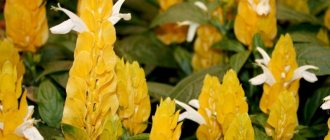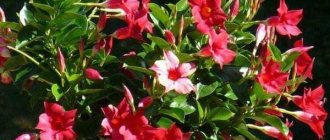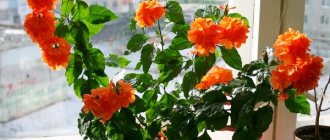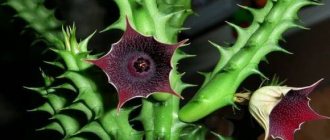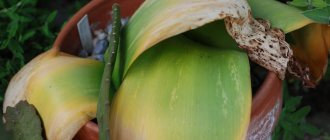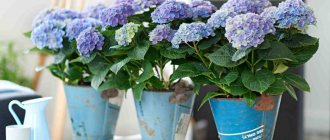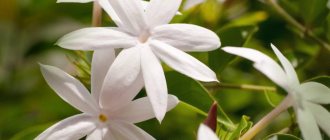Bougainvillea was exported to Europe from South America back in the 18th century and has been considered one of the most beautiful potted crops for more than two hundred years. But in our country, few people decide to cultivate this flower, for fear of not being able to cope with its “capricious disposition.” And completely in vain. For those who have been growing Bougainvillea for many years, caring for it at home does not seem too difficult. They know that their efforts will pay off with the opportunity to admire its bright and lush blooms for nine months a year.
Care and maintenance in the apartment
To get a healthy plant with high decorative properties, you will have to learn how to care for Bougainvillea in indoor growing conditions.
The main decoration of the bush is not the flowers, but the colorful, bright and attractive bracts (or bracts), which feel like thin paper to the touch. They come in a variety of shapes, sometimes triangular, sometimes round, and also in the shape of cute hearts.
Place
The indoor flower Bougainvillea loves sunlight and does not like to move. Even if you move it a couple of tens of centimeters or rotate the pot a few degrees, it can begin to shed leaves and bracts. Therefore, a permanent place for the flower is selected immediately. Usually this is a warm, well-lit window sill on a window facing South or West. Even in scorching sunlight, you should not shade the flower. If only, as an exception, in case of illness.
Air temperature
The room where Bougainvillea is kept should be heated to 23-25 °C in summer and 13-16 °C in winter. In the hot summer months, it is recommended to take the pot with the plant to the balcony, terrace or garden, remembering that this flower loves natural ventilation, but does not tolerate cold winds and drafts. From the beginning of October, domestic Bougainvillea begins to prepare for “winter rest.” At this time, she needs to be provided with a cooler temperature. If you continue to keep Bougainvillea “summer style”, it will not go into a dormant state and will continue to bloom. In this case, she will have to provide additional lighting using fluorescent lamps. But you need to remember that at high winter temperatures the buds are formed worse, as a result the next summer flowering will not be very active.
Air humidity
For normal development of Bougainvillea, the air humidity in the room should be 70-80%. To achieve this result, you can do the following:
- place wide and shallow containers or plates of water on the windowsill with the plant;
- Pour water onto the tray under the pot and add pebbles or crushed stone.
It is recommended to spray the flower itself regularly, especially in dry summers or during the heating season, from a spray bottle with soft, settled water at room temperature. If finances allow, you can purchase a special humidifier.
Watering
Bougainvillea constantly needs water, but at the same time does not tolerate “waterlogging” of the soil. Therefore, the soil in the pot on the surface should always be moderately moist, but not damp or overdried. This flower does not tolerate even short-term drought, so when going on vacation, you need to find someone who will water it while the owners are away or think about an automatic watering system. During flowering, Bougainvillea is watered frequently, and much less frequently during the dormant period, making sure that the earthen ball does not dry out.
Stagnant moisture in the drainage contributes to the development of infectious diseases of the root system. To avoid this, place the pot on pebbles, which act as a “protective cushion” between the water and the drainage hole.
Feeding
In order for Bougainvillea to bloom long and abundantly, it is regularly fed with mineral and organic fertilizers. These can be universal solutions for flowering indoor crops with a minimum nitrogen content, since it negatively affects budding and flowering. But the content of potassium, iron and phosphorus, on the contrary, should be increased. For an adult bush, it is convenient to use fertilizers in the form of sticks, without wasting time preparing the solution. By plunging such a stick into the ground, you can forget about what to feed Bougainvillea for several weeks. Each time you water, the water will partially dissolve the fertilizer and deliver nutrients to the roots. During the active growth phase, fertilizing is applied once every 5-7 days. During the dormant period, the plant is not fed.
Liana from the Nocturnal family
Bougainvillea is a genus of plants belonging to the Nectaginaceae family. In nature, the flower is found in the tropical rainforests of South America, in particular Brazil. These are beautifully flowering climbing vines with clinging thorns, although some types of bougainvillea do not have thorns. The plant is quite large: it can grow up to 15 m in height. The leaf blades, dense and pubescent, are located alternately on the flexible shoot. They reach 13 cm in length.
In countries with tropical climates, bougainvillea decorates gardens, parks and streets
The plant is popular due to its lush and long flowering. The liana is covered with small flowers, collected in several pieces. Bougainvillea flowers themselves are inconspicuous, and their brightness is given by bracts, painted in various shades of pink, lilac, violet, red, orange, yellow, white .
Bracts are not flowers, they are modified leaves.
In indoor conditions, bougainvillea is grown as a low shrub or hanging plant. With the help of special supports, the vine can be given any shape, for example, a pyramid, a wreath or a sphere .
Bougainvillea is considered a capricious plant that grows very poorly “in captivity” and feels better in a greenhouse or winter garden, where all the conditions for a tropical plant are created. But if you find the brightest and warmest place for it, and also provide the necessary care, then it is quite possible to grow bougainvillea and make it bloom in the room.
Bougainvillea was discovered by naturalist and collector of rare exotic plants Philibert Commerson, who gave it a sonorous name in honor of his friend Louis Antoine de Bougainville, the first Frenchman to cross the Pacific Ocean.
How does indoor Bougainvillea reproduce?
When grown in pots, Bougainvillea is usually propagated by seeds, air layering or cuttings. The last method is the most popular and effective.
Growing Bougainvillea seedlings from seeds
With this method of propagation at home, Bougainvillea usually blooms in the 3rd year of life. The first shoots, if the planting material is of high quality, appear in a month and a half. Theoretically, you can get Bougainvillea seeds from an adult plant. They are located in pods inside dried bracts. But in order not to be disappointed with the result, it is better to purchase them in the store.
It is advisable to sow Bougainvillea from seeds in winter. The seeds are soaked in a growth stimulator for 4-5 hours, and then sown in a container with moistened soil obtained from a mixture of peat and sand in a 50/50 ratio. The soil is pre-disinfected by calcining it for 15-20 minutes in an oven heated to 180 °C. The seeds are laid out at a distance of 3-4 cm from each other, sprinkled with soil, covered with film and left in a bright room with an air temperature of at least 25 ° C. Germination conditions are brought closer to natural by artificially extending daylight hours using fluorescent lamps. The film is periodically removed to ventilate and moisten the soil.
Air layering
Only young, flexible, non-woody shoots are suitable for this method. An incision is made on the bark of the shoot. Place a container with soil next to the pot in which the mother bush grows. The prepared shoot is bent to it and secured in the soil at the site of the cut. When the shoot takes root, the sprout is separated from the “parent” and planted in a permanent place.
Propagation of Bougainvillea by cuttings
When propagated by cuttings at home, flowering can occur as early as the next year after planting. Bougainvillea cuttings are best done in spring or summer. Young shoots or lignified branches remaining after pruning are suitable for cuttings. Cut into lengths of 8-15 cm, slightly obliquely. Each cutting must have at least two living buds, with the lower one located at a distance of at least 5 cm from the cut. Before rooting, it is recommended to dip each cutting in a root formation stimulator.
Bougainvillea cuttings can be rooted in ready-made substrate, peat tablets or in water. The latter option is rarely used, since there is a high risk of root rotting.
Rooting in water
Lignified cuttings with 3-4 buds are placed in water and left until callus (white dots from which roots begin to grow) appears on them. Usually the process takes 1.5-2 months. Then the cuttings are planted in the substrate, covered with film and rooting continues there. To prevent the formation of mold, the film is regularly removed for ventilation. 1.5-2 weeks after the roots appear, the flower is transplanted to a permanent place.
Rooting in the substrate
This method is good when young, green shoots are propagated. The best substrate is a mixture of peat and sand in a 1:1 ratio or agroperlite with vermiculite in the same ratio. The mixture is poured into a glass, watered and a 3-4 cm depression is made in it, into which the cutting is inserted. The lower bud should remain on the surface. Glasses with cuttings are covered with glass jars or polyethylene and placed on a warm windowsill, but not in direct sunlight. It is best to shade the window with a curtain. Just as when rooting in water, they are transplanted to a permanent place 1.5-2 weeks after the roots appear.
Rooting in peat tablets
A peat tablet is placed in a glass, filled with water and left until completely swollen. Then a depression is made in it, into which the cutting is inserted to a depth of 3-4 cm, but so that the lower bud remains on the surface. The glass with the cutting is placed on a warm windowsill and greenhouse conditions are created. It must be remembered that due to the high humidity of peat, there is a high probability of developing root rot. To avoid its appearance, the cuttings are regularly opened for ventilation. The cuttings, which have taken root, are transferred together with a peat ball to permanent soil. There is no need to rush into transferring. It is better to wait until the roots entwine the entire earthen ball.
Bougainvillea propagation
This vine reproduces quite easily. This can be done with aerial green layering or cuttings that have reached a certain degree of maturity. The most suitable period for breeding is May - July.
How to root stem cuttings
Procedure:
- Cut the cuttings immediately below the bud, and then treat the lower part with a special product that stimulates root formation (Kornevin, Epin or Zircon).
- Tear off all the lower leaves on the cuttings.
- Prepare a substrate for rooting cuttings. It should consist of sand and peat, taken in equal proportions. Pour the soil into a bowl and moisten it.
- Bury the cuttings in the soil mixture up to the second internode. Cover the container with planting material with a transparent plastic lid, bag or glass jar.
- Place the improvised greenhouse in a warm place with a temperature of about +25 degrees.
Cuttings root best in greenhouse conditions
- Open the cuttings twice a day and ventilate the greenhouse. As the top layer dries, water the soil and spray the cuttings with warm water. After about a month, the cuttings will take root, and after a week they can be transplanted to a permanent place.
Cuttings take root in about a month
Master class on propagation by air layering
- Select a well-developed but not yet lignified shoot on the plant.
- Make small cuts on it.
- Press these places tightly to the ground and secure with wire or a hairpin.
- Moisten the soil as usual. In two to three weeks, roots will appear on the cuttings .
- When it is well rooted, separate the new plant from the mother bush and plant it in a permanent place.
How to grow indoor bougainvillea from seeds
Growing bougainvillea from seeds is interesting, but it is a long process. In addition, the varietal qualities of the plant are not transmitted through this propagation method. As a result, you can get a plant with a completely different color of bracts .
In nature, bougainvillea seeds are spread by butterflies and hummingbirds.
Progress:
- Soak bougainvillea seeds in Epin (growth stimulant) solution for 2–3 hours.
- Place them on the surface of the soil, press lightly and moisten them with a spray bottle.
- Cover the bowl with the seeds with a transparent bag and place it on the radiator.
- Moisten the plantings daily, ventilate the greenhouse and wipe off any condensation that accumulates on the bag. Be patient, shoots will appear only after 2–3 months .
- As soon as the first true leaves appear, the bag can be removed and the seedlings can be cared for as usual.
- About six months after planting the seeds, the plants can be transplanted into separate pots.
Planting Bougainvillea in a pot
When planting Bougainvillea cuttings or seedlings from seeds, you will have to take into account many nuances, from choosing a container to choosing the most suitable location.
Pot
An indoor Bougainvillea flower does not need a spacious container. In a large pot, the vine will actively grow green mass, but will not bloom soon. A large pot is also undesirable for roots, since the process of weaving an earthen ball will take a long time and can lead to acidification of the soil. It is necessary to ensure that the holes in the bottom are large. Domestic bougainvillea does not tolerate overwatering, and in this case there will be no risk of flooding the roots, even with too much watering.
Initially, a pot with a diameter of 10-12 cm is sufficient. As the bush grows, it can be transferred to containers with a larger diameter.
Priming
The soil for Bougainvillea domestica is chosen to be nutritious, with good aeration and moisture capacity and slightly acidic (Ph not higher than 5.5). Any ready-made soil (for flowering plants or universal) meets these conditions. If the pH value is above 5.5, you can add additives that neutralize acidity, for example, vermiculite or wood ash. Among other things, they will make the soil looser and improve its aeration. You can prepare the soil yourself by mixing leaf and turf soil, humus and coarse sand (or vermiculite) in a ratio of 2:2:1:1.
Landing
A layer of drainage (expanded clay or pieces of foam plastic) 5-7 cm high is poured onto the bottom of the pot, and a substrate is placed on top of it, watered with warm water, a depression is made and the cutting is lowered vertically into it, deepening it to about 1/3 of the height. Since young roots are very fragile, you need to try not to damage them. To keep them intact, it is better not to compact the soil around the stem. You cannot immediately place the seedling in the open sun. First he must adapt to the new conditions on the windowsill with diffused, dim lighting. The cuttings are not fed for 3 weeks after planting.
Video: growing bougainvillea
Brazilian bougainvillea can still rarely be found in the collections of flower growers who consider the tropical beauty capricious. But if you provide it with high humidity and sunbathing, do not disturb it with transplants, and keep it cool in winter, then the vine will be covered with amazing flowers with incredibly bright bracts and will delight its owners with this beauty for a long time.
- Author: Olga Isakina
I am interested in many things. Handicrafts, gardening, floriculture and cooking are just a few of my hobbies. I am constantly discovering something new and learning something interesting. I am ready to share all my knowledge with my readers. Rate this article:
- 5
- 4
- 3
- 2
- 1
(2 votes, average: 5 out of 5)
Share with your friends!
How and when to replant Bougainvillea
Bougainvillea domestica is transplanted in early spring, when the flower begins to recover after winter dormancy. Until the age of three, young plants are replanted annually, then once every few years.
Bougainvillea roots have one peculiarity: they are very brittle. Therefore, if you have no experience with this plant, do not take risks. It’s better to transfer the lump into another pot.
Domestic bougainvillea does not tolerate transplants well and often begins to get sick after them, refuses to bloom, and loses leaves and bracts. To reduce risks, replanting is carried out by rolling over the bush along with a lump of earth. Under no circumstances should the roots be cleared from the soil. And so that the bush can be pulled out easily and without damage, it is watered abundantly the day before.
The new container should be 3-4 cm larger in diameter than the previous one. A drainage layer and some soil are poured onto the bottom. Bougainvillea, together with a damp earthen ball, is placed in the center and the required amount of earth is carefully poured on the sides and on top. When filling an empty space, there is no need to deeply fill the root collar and compact the substrate. After this, the bush is watered and left alone for several days on the windowsill with soft diffused light, excluding direct sunlight. For example, they curtain the window with tulle. When the plant takes root, the tulle is removed.
After transplanting, give the plant a rest for three to four days: place the pot in the shade and do not water it. This will make the adaptation period easier and faster.
Table: conditions required for vines depending on the season
| Season | Lighting | Humidity | Temperature |
| Spring Summer | Sunny place: the flower tolerates direct sunlight well, so you can place it on a south-facing window. | High humidity is required, for this you need to spray bougainvillea daily. | From +22 to +28 degrees |
| Autumn winter | A shaded place, the vine should be moved to a window facing the west side. |
| Not higher than +13 degrees and not lower than +8 degrees |
Pruning Bougainvillea
When caring for such a profusely flowering and branching plant at home, you cannot do without pruning. It must be carried out twice a year: in autumn and spring.
In the spring, as soon as Bougainvillea begins to awaken, all shoots are shortened by about half, leaving only 5-7 buds on them, thereby stimulating the growth of new shoots and the setting of buds. If this is not done, you may not wait for flowering.
In the fall, when Bougainvillea begins to prepare for the dormant period, the shoots are cut off by about a third. Autumn pruning is needed only for mature bushes that are already 3-4 years old or more.
If necessary, light pruning can also be done in the summer. It is needed so that the crown does not lose its shape, and also if rotten or dried branches appear on the bush.
In addition to pruning, bougainvillea requires pinching. They are carried out immediately after the end of the next flowering cycle. Since flowers appear only on young shoots, only growing points that have a soft structure should be pinched. In addition, it is necessary to regularly remove dried inflorescences with your hands.
If you need to trim old woody branches of an adult shrub, then it is better to buy a miniature pruner; it will quickly make the cut and will not injure the branch so much.
Types of domestic bougainvillea
There are about 15 species of bougainvillea. However, out of all the variety, only a few are grown at home:
- Bougainvillea is beautiful or wonderful. This is the most popular type in indoor floriculture. The plant has velvety leaves and large bracts that turn pale as they bloom.
- Bougainvillea is naked. A distinctive feature of the species are very spectacular purple bracts.
- Bougainvillea peruviana. This is the most stable species, capable of very long flowering.
- Bougainvillea Butte. This is a hybrid of Peruvian bougainvillea and naked bougainvillea, which became the ancestor of most modern varieties. In nature, the shoots of this plant branch reluctantly, but Bougainvillea Butte forms very spectacular stems that cascade.
Here are the popular hybrid varieties:
- Bougainvillea Sanderiana. The bracts are bright purple. It can bloom several times a year and is quite easy to care for.
- Bougainvillea Vera Deep Purple. Differs from other varieties by bright crimson bracts.
- Bougainvillea Crimson Lake. The flower captivates with its gorgeous bracts, painted in all sorts of shades of purple, burgundy and red.
- Bougainvillea Golden Tango. A distinctive feature of the variety are yellow bracts with tiny flowers.
- Bougainvillea lateritia. The variety cannot be ignored, because its bright bracts have an unusual salmon color.
- Varieties with double bracts. Among them are modern hybrids: Strawberry Lace (with pink and white double bracts);
- Bois De Roses (at the beginning of flowering, the bougainvillea bracts of this variety are bright orange in color, and then they turn pink);
- Double Lilarose is distinguished by luxurious bracts, the palette of which includes all shades of pink, lilac or salmon.
- San Diego Red Variegata;
Often, several plants with different colored bracts are planted in one container to create an interesting composition.
Photo gallery: bougainvillea with regular and double bracts of different colors
Bougainvillea beautiful has large bracts. Bougainvillea peruviana produces few side shoots.
Bougainvillea glabra has purple bracts
Bougainvillea variety Vera Deep Purpl has bright crimson bracts
The bracts of Bougainvillea Lateritia are salmon-colored.
A distinctive feature of the bougainvillea variety Golden tango is its yellow bracts with tiny flowers.
Bougainvillea Sanderiana bracts are purple
The bracts of bougainvillea Strawberry Lace are striking in their variegated colors.
Bougainvillea variety Double Lilarose is distinguished by luxurious bracts of all shades of pink
Bougainvillea variety San Diego Red Variegata has foliage with white and green streaks
How to shape Bougainvillea
The crown of Bougainvillea can be formed in the form of a standard or hanging form, a bush or a bonsai. The older the bush, the more difficult it is to give it the intended shape, so ideally they begin to form the crown from the rooted cuttings stage.
Ampelous Bougainvillea
The ampelous form is shoots that hang freely below the level of the roots. In this case, the pot is located high: suspended from the ceiling or standing on a high shelf or a special stand. As they grow, the shoots are shortened, pinched and faded inflorescences are removed.
Formation of standard Bougainvillea
Forming a trunk is a complex and lengthy procedure that can take several years. It consists of the following steps:
- A support is inserted at a distance of 3-4 cm from the rooted cuttings. Its height is equal to the sum of the length of the future trunk and the expected diameter of the crown. The shoot is pulled to the support and secured with masking tape.
- When the shoot outgrows the support by 5-6 cm, the growth point is pinched, thereby stimulating branching.
- As it grows, all shoots developing on the trunk are removed, except for the top 5-7. They will develop into skeletal branches and in the future will form a beautiful, neat crown.
Skeletal shoots must be formed as soon as they develop, without waiting for their lignification. When the crown is formed, bougainvillea is pinched and pruned in spring and autumn, and to maintain its shape, shoots that extend beyond the intended outline are removed.
Formation of a figured bush
To form a bush, a wire fence of the intended shape is installed around it. Developing young shoots are guided along it and secured as they develop. When the base of the future figure is formed, they begin to prune, exactly the same as for the trunk, but without removing the lower branches.
Bougainvillea bonsai
Many varieties are suitable for cultivating Bougainvillea in the bonsai style, including those obtained by crossing the endemic Bougainvillea Naked with all sorts of hybrids: Mini Thai and Mini Thai Variegate, Pedro, Pink Clouster, Little Guy, Doble Red and some others.
A Bonsai tree is grown according to the same principle as a standard one. With the help of a wire frame, Bougainvillea or its individual parts are given the intended shape. And in order to restrain the growth of the trunk, the size of the planting container is limited. Experienced craftsmen even practice grafting multi-colored varieties onto one trunk. This bonsai looks incredibly decorative.
Proper care for a tropical beauty
Watering and fertilizing
From early spring (from the beginning of the active growing season) until the end of August, bougainvillea should be watered frequently, but moderately. Each subsequent watering should be done after the top layer of the substrate in the container with the plant has dried . In autumn and winter (during hibernation), watering should be significantly reduced and the plant should be moistened once a week, while the volume of water for irrigation should be halved. After such stress, the plant will bloom very profusely.
This plant is very demanding of moisture, so watering alone will not be enough. Bougainvillea should be regularly sprayed with warm water from a spray bottle. But during the flowering period, be careful, droplets of water should not fall on the bracts.
There is no need to keep bougainvillea on dry rations. In spring and summer it requires frequent feeding. Fertilize every two weeks . In the spring, fertilize with organic matter; to do this, dilute an infusion of bird droppings or mullein in a concentration of 1:30. Apply the solution after watering to avoid burning the roots. At the end of spring, fertilize with complex fertilizer for flowering indoor plants. Fertilizing preparations are sold in a convenient form; you just need to dilute them according to the instructions and water the plant.
What to do to speed up flowering time
Bougainvillea usually blooms in late spring, with the onset of sunny days. This process can be accelerated by providing the plant with good lighting. Fluorescent lamps are suitable for this purpose and should be placed at a distance of 30 cm from the plant. Another condition for flowering is a dormant period. After resting, the vine becomes covered with buds and blooms for a long time.
To ensure that your vine blooms profusely, give it periods of rest.
As a rule, bougainvillea blooms once a year, but it can be forced to do so repeatedly. To get a second wave of flowering, the plant needs to do the following:
- After the bougainvillea has finished blooming, cut off the shoots by one third.
- Place the pot in a semi-shaded place.
- Reduce watering.
- After a month, move the flower to a sunny place and resume watering as usual.
After stress, your beauty will bloom again, but the size of the bracts will be smaller than during the first flowering.
Dormant period - the vine sheds its leaves
With the onset of autumn, bougainvillea begins a dormant period. A sign of this is the dropping of leaves. During the period of “hibernation,” the flower needs to create certain conditions, which is quite difficult to do in city apartments.
In the fall, you need to completely stop fertilizing and reduce the frequency and volume of watering. The most important thing is to provide the plant with the necessary temperature in winter. The optimal option is from 8 to 10 degrees. At temperatures below eight degrees the flower will begin to freeze, and at +13 it will begin to grow and the plant will weaken.
Pruning and crown formation
Bougainvillea blooms on young shoots, so it needs to be pruned after each flowering. This will not only stimulate flowering, but will also form a lush bush.
By pruning you can not only form the desired shape, but also stimulate the flowering of bougainvillea
By pruning you can give bougainvillea any shape. The crown can be round on a trunk or in the form of a pyramid or sphere. Cardinal pruning is done twice a year: in early spring and after flowering . In other periods, you can slightly adjust the shape of the bush by pinching it.
When forming an ampelous form, the shoots are allowed to grow without cutting off the apical bud. All side branches should be trimmed periodically.
Caring for Bougainvillea at home in winter
In winter, indoor Bougainvillea lies dormant and prepares for summer flowering. Life processes inside the plant slow down, the above-ground part ceases to develop vegetatively. In order for Bougainvillea to winter without stress, and to bring the flower to summer in good condition, the following conditions must be observed:
- air temperature + 10+16 °C;
- natural lighting as possible;
- frequency of watering is rare (do not allow the earthen clod to dry out);
- stop feeding.
As soon as the days begin to increase and the weather warms, you can return to normal care conditions.
Landing
Streptocarpus - care and cultivation at home
For successful breeding, it is necessary to study the features of planting a bougainvillea flower, growing and caring for the planted plant.
Selecting a location
The flower should be grown on the western or southern windowsill of the apartment. In the chosen location, the plant should be illuminated by sunlight for at least five hours a day. It is contraindicated to grow bougainvillea in shaded areas, as in the shade it slows down its growth and stops blooming. Lack of lighting can lead to pale foliage and elongated shoots.
A lit windowsill is the best place for bougainvillea.
Important! The flower cannot be grown on the balcony, especially in winter. At temperatures below ten degrees Celsius, the bush may begin to wither and die.
Selection of capacity
To grow tall and well-flowering bougainvillea, you need to choose a suitable pot. The root system of the flower does not grow very widely, so it is not necessary to choose a container that is too deep for planting. An average pot 25-35 cm high will be enough. Moisture will not stagnate in it and the soil will not begin to sour.
Planting
The step-by-step process for planting bougainvillea is as follows:
- Soil preparation. To begin with, the pot in which the flower will be grown is filled with soil. It is necessary to grow a tropical plant in light soil, which is well-permeable and quickly absorbs moisture. To make the planted plant grow faster, add 20-30 g of river sand and wood ash to the soil.
- Creating a hole. If seeds are planted in the ground, the depth of the hole should be 4-5 cm. When transplanting germinated cuttings, you will have to make a deeper hole - at least 8-10 cm.
- Landing. Planting material is placed in a dug hole, sprinkled with soil and watered with heated water.
Why doesn't Bougainvillea bloom?
The question of why Bougainvillea does not bloom at home is one of the most pressing for gardeners. The reason almost always lies in the fact that not all care rules were followed or were carried out improperly:
- conditions that were comfortable for the plant during the dormant period were not provided;
- comfortable conditions for the plant were not provided in the cold, cloudy summer;
- during the year a sufficient level of illumination was not provided;
- a pot that was too spacious was chosen and the roots were unable to occupy the entire space;
- watering was carried out incorrectly: the earthen ball either dried out or became waterlogged;
- There was too much nitrogen in the fertilizer.
If all the rules of care and maintenance have been scrupulously observed, but Bougainvillea still does not bloom, you can try to force it to bloom. Before making Bougainvillea bloom, fertilizing and spraying are completely stopped, and watering is carried out only when the top layer of soil dries out. When flower buds appear on the shoots, the usual regime of care and maintenance is resumed.
If the bracts do not turn bright colors in summer and remain pale, the tropical flower is reporting that this season has been too cool for it.
general description
Bougainvillea is a perennial flower that belongs to the Nociaceae family. Under natural conditions, the plant can be found in South America, as well as in countries where the sun shines most of the day. In such conditions, the flower is able to bloom throughout the year.
Colorful bougainvillea buds
Additional Information. Despite the fact that the plant loves sunny countries, it can be grown in any corner of the planet. The main thing is that suitable conditions are created for it.
Externally, indoor bougainvillea looks like a bright green climbing shrub. In its natural environment, its height reaches five and a half meters. The stems of the bush are covered with long pointed thorns. Their number depends on the age of the plant. The stems of young bushes contain virtually no thorns. However, over time, their number begins to gradually increase.
The leaves of the bush are green and resemble the foliage of young lilacs. They have a smooth leaf blade, a solid edge and a slightly oval shape. In mid-summer, small flowers begin to form on the stems. Their petals are bright purple with an orange tint. Each inflorescence contains 3-4 flowers. Among the features of bougainvillea is the pleasant and rich aroma emanating from the buds during flowering.
Bougainvillea diseases and pests
Diseases of Bougainvillea caused by various pests are almost always manifested by lethargy and falling of leaves and bracts and deterioration of growth in general. But if you know what to do in these cases and take action in time, any disease can be cured quickly enough.
Why does Bougainvillea shed its leaves?
A situation where Bougainvillea has dropped all or part of its leaves is not uncommon. Its reasons may be the following:
- Natural process. If the leaves turn yellow and begin to fall off with the arrival of autumn and gradually, treatment is not necessary. The bush sheds last year's leaves in order to rest and gain vitality before the new growing season.
- Incorrect watering. Bougainvillea reacts sharply to lack and excess of moisture. If the earthen lump regularly dries out, its leaves turn black, and it begins to shed everything unnecessary, trying to survive. A similar situation occurs when the roots cannot cope with excess moisture and do not have time to absorb it.
- Relocation to a new location. Bougainvillea tolerates a change of location extremely poorly. The flower may begin to shed its leaves, even if the pot is rotated around its axis when pruned. That is why you need to decide on a permanent place for it right away, and when forming the crown, try not to rotate the flower.
- Dry air and insufficient lighting. Bougainvillea loves bright sun and when there is a lack of it, it almost always begins to shed its green mass. She reacts in the same way to dry air in the room. Therefore, it is so important to place the flower on a bright southern or, in extreme cases, western windowsill and regularly spray it with warm, settled water.
- Consequences of transplantation. It is likely that after transplantation, Bougainvillea will begin to hurt and crumble. Like the vast majority of ornamental plants, it needs time to adapt to new conditions. To make adaptation easier, you can cover the flower with a plastic bag, creating greenhouse conditions for it.
Do not rush to throw away the bush, even if it seems that it is completely dry. Cut off the branch. The cut is “live” - there is a chance that the plant will recover. If a flower has dropped its leaves before wintering, keep it cool and try not to over-water it. It seems that Bougainvillea has dried out in the summer - give it a “greenhouse”.
Root rot
If the room is cold and watering is excessive, Bougainvillea may be affected by root rot. Because of it, the shoots and leaves turn black, and mold appears on the roots. In this case, it is impossible to revive the bush. The only thing that can be done is to cut into cuttings and root the intact parts of the shoots and grow the flower again, not forgetting to properly follow the care and maintenance regime in the future.
Spider mite
Yellowing and falling leaves of Bougainvillea can also be caused by spider mites. To find out the reason you will have to take a closer look. If the branches are entwined with thin white cobwebs, wipe the affected areas with a damp cloth or sponge, and then spray the plant with an insecticide.
Aphid
Aphids can cause the greatest damage from spring to mid-October. It is located on the underside of the leaf blade, sucks out all the juices from it and may be one of the reasons why Bougainvillea leaves curl. Also, when affected by this pest, the bracts become deformed, and young shoots die. Only an insecticide and removal of the affected areas will help against aphids.
Mealybug
If dirty white balls appear on the leaves, resembling small pieces of cotton wool, this is a mealy worm. This pest also feeds on the vital juices of plants and causes them to wither. You can remove it using a gauze swab soaked in ethyl alcohol. The leaves are then treated with an insecticide. After a week, the treatment is repeated.
To grow the capricious beauty of Bougainvillea, flower growers have to put a lot of effort and know all the nuances of its care and maintenance. But their efforts pay off many times over, because this plant fills the house with positive energy, beauty and comfort.
Reviews from flower growers
My bougainvillea is very tiny, it blooms and pleases more than it grows, which doesn’t upset me at all, it’s such a compact beauty.
Caring for it is very simple, do not overwater it, water it when the earthen lump dries well, and provide a sunny place, after all, this is a guest of their hot countries, and the sunnier it is, the more comfortable it is, but it’s not worth “frying” for days, it will shed its leaves . In summer, of course, it is more active, but if the necessary conditions are provided in winter, it will continue to delight with flowering and create a feeling of an approaching vacation! kat-malysh
https://irecommend.ru/content/bugenvilliya-privet-iz-zharkogo-schastlivogo-leta
Every summer, from April to late autumn, bougainvillea delights with its flowering.
I wanted to get it for a long time, twice I brought cut cuttings from Turkey, two of them even took root, but then they still died. Finally, I managed to buy an adapted small plant in my city. My buga is not purebred, just scarlet. It grows on the western window, stands on the loggia at the very edge near the wall covered with clapboard. The tree heats up in the sun and warms the flower. My bougainvillea is “fried” in the sun. It can withstand overdrying, and you can see when it’s exactly time to water: the leaves become limp and droop. I haven’t changed the soil for 5 years and it blooms beautifully. She entangled everything in the pot with roots so that even a stick couldn’t stick in. There is no room for a larger pot, and I don’t want to tug and disturb the plant by replacing the soil. Tintinka
https://irecommend.ru/content/bugenvilliya-na-zapadnom-okne
My husband gave me this beautiful vine, knowing about my desire to fill the house with greenery and flowers.
I searched the whole city, barely found it, and brought in a florist I knew. It turned out that in Ryazan this is a rather expensive and rare plant. In our apartment the sun lives half the day, so we have to carefully select plants so that they do not suffer from excess sunlight. But I somehow don’t want to cover the windows with gauze, and I don’t have time. Bougainvillea is ideal in our case, because in their homeland - Brazil, for example, these vines happily bask in the sun all day long. This is why the local population fell in love with them as decoration for all kinds of hedges. KOSCHECHKA-BLACK
https://otzovik.com/review_247766.html
Our Bougainvillea winters in an apartment on the windowsill and stands near the radiator.
The only drawback is that in such conditions it sheds leaves that need to be removed. But the plant quickly recovers and produces many new shoots. There was no experience with wintering in open ground, but in Crimea this plant overwinters exactly like this. But the climate is also significantly different. For ten years we have already become accustomed to the fall of leaves in winter, but every year Bougainvillea pleases us with its flowers. Our family loves this plant and calls it the lilac tree. VikTan77
https://otzovik.com/review_570847.html
The beauty does not require special care, but if something doesn’t suit her, she sprinkles it with leaves (autumn includes).
Does not like dry soil. I feed with universal fertilizer, such as Kemira-Lux, without fanaticism. When she likes everything, it blooms almost constantly. In winter it rests and does not bloom. No matter how much I try, I can’t root a branch, it just doesn’t work. Overall, I recommend it, especially if you come across a hybrid one. COLORS OF SUMMER
https://irecommend.ru/content/naryadnyi-kustik-na-yuzhnom-okne
Bougainvillea diseases
Bougainvillea is quite unpretentious to growing conditions, however, if the flower is not properly cared for, the plant can get sick.
The leaves are falling
Before wintering, leaf flying is considered normal. However, at other times of the year, the cause of leaves flying may be the presence of drafts or the transfer of bougainvillea from one window to another. In addition, the crop does not tolerate moving well, so the foliage often falls off after purchasing a new individual.
The foliage has faded
Dullness and lethargy of leaves is the first sign of chlorosis. The cause of this condition is considered to be insufficient intake of iron and other minerals into the plant. To return to its previous state, the plant is fed and fertilized with iron-containing fertilizers.
Spots on leaves
The reason for this condition is stagnation of water in the substrate. To eliminate the problem, foliage covered with spots is removed, and the plant is provided with regular watering and ventilation.
Yellowing and leaf loss
The reason is an excessive amount of watering, which leads to souring of the rhizome and the appearance of stagnant moisture. To eliminate this problem, the crop is provided with regular watering, depending on the season and the period of active growth.
Growth has stopped
To stimulate growth, it is necessary to transplant the crop into a larger pot. Because growth stunting often occurs due to insufficient space inside the pot for roots to develop. Growth also stops in old bushes. In this case, it is necessary to propagate the crop to obtain a young plant.
Pests
Bougainvillea is rarely damaged. Sometimes sucking insects appear on the flower, sucking juice and nutrients from the leaves. Bougainvillea pests include aphids, spider mites and powdery mildew. Problems can be eliminated using fungicides.
Types and varieties
The bougainvillea genus is small; it includes only 14 plant species. Popular varieties for growing in the garden and at home:
- Bougainvillea naked . The variety got its name due to the absence of thorns on the stem. During the flowering period, and in the southern regions it lasts up to 9 months, the plant produces small golden flowers surrounded by crimson bracts. They can grow both around the flower and around the entire inflorescence.
- Bougainvillea is beautiful . Long curving shoots are covered with dark velvety leaves. During the flowering period, the shrub is covered with a cap of numerous snow-white flowers.
- Bougainvillea peruviana . The variety differs from others in that it does not produce side shoots. The branches are covered with narrow long leaves with thorns at the base. Multi-flowered Peruvian bougainvillea has double stipules with a slightly wrinkled surface.


